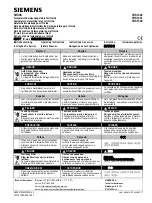
7-14
Maintenance and Testing
Date Code 20000421
SEL-251, -2, -3 Instruction Manual
Definite-Time Overcurrent Element Timing Tests
Purpose:
Verify operating times for the following definite-time overcurrent elements.
50LT
Phase definite-time overcurrent element
50QT
Negative-sequence definite-time overcurrent element
50NLT
Ground/Residual definite-time overcurrent element
Method:
1. Disable all external and internal torque control on the definite-time overcurrent
element pickups in Relay Word row R1. The above definite-time overcurrent
elements are derived from their respective pickups in Relay Word row R1. If
one of these pickups in Relay Word row R1 is torque controlled, the respective
definite-time overcurrent element it drives in Relay Word row R2 is also torque
controlled.
Using the SET command, enter
NA
for the ETC(1) and ITC(1) settings. These
settings specify the overcurrent elements in Relay Word row R1 you want
externally and internally torque controlled, respectively (none in this case).
2. Set a programmable output (A1-A4) to follow a definite-time overcurrent
element pickup (e.g.,
50NL
). Use the assertion of this output (open to close) to
start an external timer.
3. Set another programmable output to follow definite-time overcurrent element
timeout via Relay Word bit 50NLT (
50NL
drives
50NLT
). Use the assertion of
this output to stop the external timer.
4. Apply current to one phase over the 50NL pickup setting. The time shown on
the timer should match the 50NLT time delay setting.
Note:
With current applied to only one phase (e.g., I
A
= 6 A, I
B
= I
C
= 0),
the following sequence currents result:
[
]
[
]
( )
( )
[
]
I
I
I
I
A
A
A
A
I
I
a
I
a I
A
B
C
A
B
C
0
1
3
1
3
2
1
3
2
6
0
0
0
0
0
2
0
=
+
+
=
Ð °+
Ð °+
Ð °
=
Ð °
=
+
+
Where: a
and a
º Ð
°
º Ð
°
1 120
1 240
2
(
)
(
)
[
]
[
]
I
A
A
A
A
A
A
A
2
1
3
1
3
6
0
0
0
240
0
0
120
6
0
0
120
0
120
2
0
=
Ð °+
Ð °+
° +
Ð °+
°
=
Ð °+
Ð-
°+
Ð
°
=
Ð °
The negative-sequence and ground/residual overcurrent elements respond to
3xI
2
and 3xI
0
currents, respectively. Thus, for this test all overcurrent
elements see 6 A.
















































